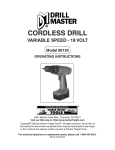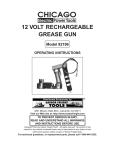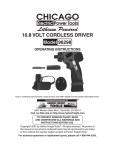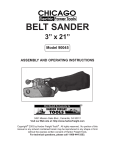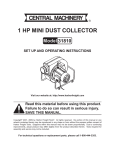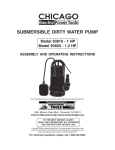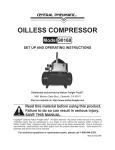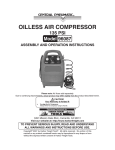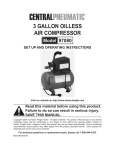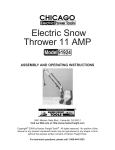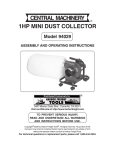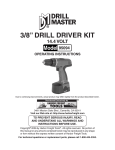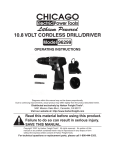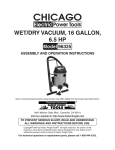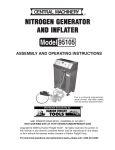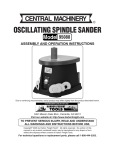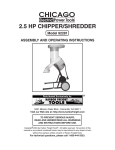Download Harbor Freight Tools 93830 User's Manual
Transcript
18V RECIPROCATING SAW 93830 ASSEMBLY AND OPERATING INSTRUCTIONS Due to continuing improvements, actual product may differ slightly from the product described herein. ® 3491 Mission Oaks Blvd., Camarillo, CA 93011 Visit our Web site at http://www.harborfreight.com TO PREVENT SERIOUS INJURY, READ AND UNDERSTAND ALL WARNINGS AND INSTRUCTIONS BEFORE USE. Copyright© 2005 by Harbor Freight Tools® . All rights reserved. No portion of this manual or any artwork contained herein may be reproduced in any shape or form without the express written consent of Harbor Freight Tools. For technical questions and replacement parts, please call 1-800-444-3353. Contents UNPACKING.............................................................................. 2 PRODUCT SPECIFICATIONS................................................... 3 GENERAL SAFETY RULES ..................................................... 3 CHARGING THE BATTERY ..................................................... 10 OPERATION ............................................................................. 11 Reciprocating Saw ......................................................................... 11 INSPECTION, MAINTENANCE, AND CLEANING ................... 12 PARTS LISTS AND DIAGRAMS .............................................. 13 Parts List/Diagram - Reciprocating Saw ...................................... 13 UNPACKING When unpacking, check to make sure all the parts shown on the Parts Lists at the end of the manual are included. If any parts are missing or broken, please call Harbor Freight Tools at the number shown on the cover of this manual as soon as possible. Note: Before first use, the Batteries (47) will require charging. The first charge requires 8 hours charge time for each battery. See charging instructions on page 10. SKU 93830 For technical questions, please call 1-800-444-3353. Page 2 PRODUCT SPECIFICATIONS Item Description AC Charger Adapter Input: 120 VAC / 60 Hz Output: 24 VDC, 400 mA Charge Time: 3 to 5 Hours; 8 Hour Initial Charge Reciprocating Saw 7/ Accessories 1 Rechargeable 18 VDC Battey; Batter y Charger/ Adapter 8" Stroke; 0-2300 SPM; Safety Trigger Save This Manual You will need this manual for the safety warnings and precautions, assembly, operating, inspection, maintenance and cleaning procedures, parts list and assembly diagram. Keep your invoice with this manual. Write the invoice number on the inside of the front cover. Keep this manual and invoice in a safe and dry place for future reference. GENERAL SAFETY RULES WARNING! READ AND UNDERSTAND ALL INSTRUCTIONS Failure to follow all instructions listed below may result in electric shock, fire, and/or serious injury. SAVE THESE INSTRUCTIONS Work Area 1. Keep your work area clean and well lit. Cluttered benches and dark areas invite accidents. 2. Do not operate power tools in explosive atmospheres, such as in the presence of flammable liquids, gases, or dust. Power tools create sparks which may ignite the dust or fumes. SKU 93830 For technical questions, please call 1-800-444-3353. Page 3 3. Keep bystanders, children, and visitors away while operating a power tool. Distractions can cause you to lose control. Protect others in the work area from debris such as chips and sparks. Provide barriers or shields as needed. Do not allow children to handle or play with these products. Electrical Safety 4. Grounded tools must be plugged into an outlet properly installed and grounded in accordance with all codes and ordinances. Never remove the grounding prong or modify the plug in any way. Do not use any adapter plugs. Check with a qualified electrician if you are in doubt as to whether the outlet is properly grounded. If the tools should electrically malfunction or break down, grounding provides a low resistance path to carry electricity away from the user. 5. Double insulated tools are equipped with a polarized plug (one blade is wider than the other). This plug will fit in a polarized outlet only one way. If the plug does not fit fully in the outlet, reverse the plug. If it still does not fit, contact a qualified electrician to install a polarized outlet. Do not change the plug in any way. Double insulation eliminates the need for the three wire grounded power cord and grounded power supply system. 6. Avoid body contact with grounded surfaces such as pipes, radiators, ranges, and refrigerators. There is an increased risk of electric shock if your body is grounded. 7. Do not expose power tools to rain or wet conditions. Water entering a power tool will increase the risk of electric shock. 8. Do not abuse the Power Cord. Never use the Power Cord to carry the tools or pull the Plug from an outlet. Keep the Power Cord away from heat, oil, sharp edges, or moving parts. Replace damaged Power Cords immediately. Damaged Power Cords increase the risk of electric shock. 9. When operating a power tool outside, use an outdoor extension cord marked “W-A” or “W”. These extension cords are rated for outdoor use, and reduce the risk of electric shock. Personal Safety 10. Stay alert. Watch what you are doing, and use common sense when operating a power tool. Do not use a power tool while tired or under the influence of drugs, alcohol, or medication. A moment of inattention while operating power tools may result in serious personal injury. 11. Dress properly. Do not wear loose clothing or jewelry. Contain long hair. Keep your hair, clothing, and gloves away from moving parts. Loose clothes, jewelry, or long hair can be caught in moving parts. SKU 93830 For technical questions, please call 1-800-444-3353. Page 4 12. Avoid accidental starting. Be sure the Power Switch is off before plugging in. Carrying power tools with your finger on the Power Switch, or plugging in power tools with the Power Switch on, invites accidents. 13. Remove adjusting keys or wrenches before turning the power tool on. A wrench or a key that is left attached to a rotating part of the power tool may result in personal injury. 14. Do not overreach. Keep proper footing and balance at all times. Proper footing and balance enables better control of the power tool in unexpected situations. 15. Use safety equipment. Always wear eye protection. Dust mask, nonskid safety shoes, hard hat, or hearing protection must be used for appropriate conditions. Always wear ANSI approved safety goggles and a dust mask/respirator when using or performing maintenance on this tool. Tool Use and Care 16. Use clamps (not included) or other practical ways to secure and support the workpiece to a stable platform. Holding the work by hand or against your body is unstable and may lead to loss of control. 17. Do not force the tool. Use the correct tool for your application. The correct tool will do the job better and safer at the rate for which it is designed. Do not force the tool and do not use the tool for a purpose for which it is not intended. Do not modify this product. 18. Do not use the power tool if the Power Switch does not turn it on or off. Any tool that cannot be controlled with the Power Switch is dangerous and must be replaced. 19. Disconnect the Power Cord Plug from the power source before making any adjustments, changing accessories, or storing the tool. Such preventive safety measures reduce the risk of starting the tool accidentally. Always unplug the tool from its electrical outlet before performing any inspection, maintenance, or cleaning procedures. 20. Store idle tools out of reach of children and other untrained persons. Tools are dangerous in the hands of untrained users. 21. Maintain tools with care. Keep cutting tools sharp and clean. Properly maintained tools with a sharp cutting edge are less likely to bind and are easier to control. Do not use a damaged tool. Tag damaged tools “Do not use” until repaired. 22. Check for misalignment or binding of moving parts, breakage of parts, and any other condition that may affect the tool’s operation. If damaged, have the tool serviced before using. Many accidents are caused by poorly maintained tools. SKU 93830 For technical questions, please call 1-800-444-3353. Page 5 23. Use only accessories that are recommended by the manufacturer for your model. Accessories that may be suitable for one tool may become hazardous when used on another tool. Service 24. Tool service must be performed only by qualified repair personnel. Service or maintenance performed by unqualified personnel could result in a risk of injury. 25. When servicing a tool, use only identical replacement parts. Follow instructions in the “Inspection, Maintenance, And Cleaning” section of this manual. Use of unauthorized parts or failure to follow maintenance instructions may create a risk of electric shock or injury. Grounding WARNING! Improperly connecting the grounding wire can result in the risk of electric shock. Check with a qualified electrician if you are in doubt as to whether the outlet is properly grounded. Do not modify the power cord plug provided with the tool. Never remove the grounding prong from the plug. Do not use the tool if the power cord or plug is damaged. If damaged, have it repaired by a service facility before use. If the plug will not fit the outlet, have a proper outlet installed by a qualified electrician. Grounded Tools: Tools With Three Prong Plugs 1. Tools marked with “Grounding Required” have a three wire cord and three prong grounding plug. The plug must be connected to a properly grounded outlet. If the tool should electrically malfunction or break down, grounding provides a low resistance path to carry electricity away from the user, reducing the risk of electric shock. (See Figure A.) 2. The grounding prong in the plug is connected through the green wire inside the cord to the grounding system in the tool. The green wire in the cord must be the only wire connected to the tool’s grounding system and must never be attached to an electrically “live” terminal. (See Figure A.) SKU 93830 For technical questions, please call 1-800-444-3353. Page 6 3. Your tool must be plugged into an appropriate outlet, properly installed and grounded in accordance with all codes and ordinances. The plug and outlet should look like those in the following illustration. (See Figure A.) FIGURE A Double Insulated Tools: Tools With Two Prong Plugs 4. Tools marked “Double Insulated” do not require grounding. They have a special double insulation system which satisfies OSHA requirements and complies with the applicable standards of Underwriters Laboratories, Inc., the Canadian Standard Association, and the National Electrical Code. (See Figure B.) 5. Double insulated tools may be used in either of the 120 volt outlets shown in the following illustration. (See Figure B.) FIGURE B Extension Cords 1. Grounded tools require a three wire extension cord. Double Insulated tools can use either a two or three wire extension cord. 2. As the distance from the supply outlet increases, you must use a heavier gauge extension cord. Using extension cords with inadequately sized wire causes a serious drop in voltage, resulting in loss of power and possible tool damage. (See Figure C, next page.) 3. The smaller the gauge number of the wire, the greater the capacity of the cord. For example, a 14 gauge cord can carry a higher current than a 16 gauge cord. (See Figure C.) SKU 93830 For technical questions, please call 1-800-444-3353. Page 7 4. When using more than one extension cord to make up the total length, make sure each cord contains at least the minimum wire size required. (See Figure C.) 5. If you are using one extension cord for more than one tool, add the nameplate amperes and use the sum to determine the required minimum cord size. (See Figure C.) 6. If you are using an extension cord outdoors, make sure it is marked with the suffix “W-A” (“W” in Canada) to indicate it is acceptable for outdoor use. 7. Make sure your extension cord is properly wired and in good electrical condition. Always replace a damaged extension cord or have it repaired by a qualified electrician before using it. 8. Protect your extension cords from sharp objects, excessive heat, and damp or wet areas. RECOMMENDED MINIMUM WIRE GAUGE FOR EXTENSION CORDS* NAMEPLATE AMPERES (At Full Load) 0 - 2.0 EXTENSION CORD LENGTH 25 Feet 50 Feet 75 Feet 100 Feet 150 Feet 18 18 18 18 16 2.1 - 3.4 18 18 18 16 14 3.5 - 5.0 18 18 16 14 12 5.1 - 7.0 18 16 14 12 12 7.1 - 12.0 18 14 12 10 - 12.1 - 16.0 14 12 10 - - 16.1 - 20.0 12 10 - - - FIGURE C * Based on limiting the line voltage drop to five volts at 150% of the rated amperes. Symbology SKU 93830 For technical questions, please call 1-800-444-3353. Page 8 Specific Safety Rules 1. 2. 3. 4. 5. 6. 7. 8. 9. 10. 11. Maintain a safe working environment. Make sure there is adequate surrounding workspace. Always keep the work area free of obstructions, grease, oil, trash, and other debris. Maintain labels and nameplates on this item. These carry important information. If unreadable or missing, contact Harbor Freight Tools for a replacement. When using a handheld power tool, always maintain a firm grip on the tool with both hands. To avoid electrical shock, do not pull or carry the AC Charger Adapter (53) by its Power Cord or pull the Power Cord around sharp corners or edges. Do not unplug the AC Charger Adapter by pulling on the Power Cord. Keep the Power Cord away from heated surfaces. Never leave the AC Charger Adapter (53) unattended when it is plugged in. Make sure to unplug the AC Charger Adapter from its outlet before leaving. Proper Battery Care: Battery (47) leakage may occur under extreme usage or temperature conditions. If Battery fluid comes in contact with skin, wash with soap and water and rinse with lemon juice and vinegar. If the fluid comes in contact with eyes, flush with water for several minutes and contact a doctor immediately. Never burn the Battery, as it can explode in a fire. Do not attempt to charge a leaking Battery. Contact local solid waste authorities for instructions on correct disposal or recycling of the Battery. Store idle equipment. When not in use, tools and equipment should be stored in a dry location to inhibit rust. Always lock up tools and equipment, and keep out of reach of children. Industrial applications must follow OSHA requirements. WARNING! Some dust created by power sanding, sawing, grinding, drilling, and other construction activities, contain chemicals known (to the State of California) to cause cancer, birth defects or other reproductive harm. Some examples of these chemicals are: lead from lead-based paints, crystalline silica from bricks and cement or other masonry products, arsenic and chromium from chemically treated lumber. Your risk from these exposures varies, depending on how often you do this type of work. To reduce your exposure to these chemicals: work in a well ventilated area, and work with approved safety equipment, such as those dust masks that are specially designed to filter out microscopic particles. (California Health & Safety Code § 25249.5, et seq.) WARNING! People with pacemakers should consult their physician(s) before using this product. Electromagnetic fields in close proximity to a heart pacemaker could cause interference to or failure of the pacemaker. WARNING! The warnings, precautions, and instructions discussed in this manual cannot cover all possible conditions and situations that may occur. The operator must understand that common sense and caution are factors which cannot be built into this product, but must be supplied by the operator. SKU 93830 For technical questions, please call 1-800-444-3353. Page 9 CHARGING THE BATTERY Note: Always switch to a fresh battery when tool performance begins to diminish. Severe heat is most destructive to a battery; the more heat generated, the faster the battery loses power. A battery that gets too hot can be permanently damaged. Never over-discharge a battery by using the tool even after tool performance is decreasing. Never attempt to discharge a tool’s battery by continuing to pull the tool trigger. When tool performance begins to diminish, stop the tool, recharge the battery and use the fresh battery for optimal performance. 1. When a Battery (47) requires recharging, a 3 to 5 hour* charge allows the tool to operate at full power. Do not recharge the Battery longer than 5 hours*, as damage to the Battery and/or tool will occur. 2. To charge the Battery (47), plug the AC Charger Adapter’s (53) plug into the Charger (52). Insert the Charger (52) onto the top of the Battery (47) until it locks into place. Charging room temperature: 50° F - 104° F. Then, plug the AC Charger Adapter into the nearest 120 Volt, grounded, electrical outlet. (See illustration below.) 3. Two Charging Indicator LEDs on the Charger (52) will illuminate to show that charging is taking place. NOTE: The AC Charger Adapter (53) will not automatically turn off when the Battery is fully charged, and the Charging Indicator LEDs will remain on until the AC Charger Adapter is disconnected from the electrical outlet. Recharging the Battery more than 5 hours* can cause damage to the battery cells. 4. While charging, the Battery (47), AC Charger Adapter (53), and/or Charger (52) may become warm to the touch. This is normal, and does not indicate a problem. 5. Once the Battery (47) is fully charged, disconnect the AC Charger Adapter (53) from the electrical outlet. Then, disconnect the Charger from the Battery. * The Battery (47) require an initial charge time of 8 hours. Do not recharge the Battery more than 5 hours after this initial charging. SKU 93830 For technical questions, please call 1-800-444-3353. Page 10 OPERATION Note: For additional information regarding the parts listed in the following pages, refer to the Assembly Diagrams at the end of the manual. Reciprocating Saw WARNING: Always make sure the Battery (47) of the Reciprocating Saw is removed prior to making any adjustments to the tool. 1. Slide the Battery (47) into the base of the Reciprocating saw. Note: Do not start the Reciprocating Saw if the Saw Blade (23) is in contact with anything before operation. If necessary, lift the Reciprocating Saw to free the Saw Blade before squeezing the Trigger. 2. NEVER cut into areas where you cannot identify any possible hazards behind or inside the surface being cut. 3. Hold the Reciprocating Saw firmly with both hands, then slide the Safety (37) to one side and squeeze the Trigger (41) to start the Saw. 4. With the Reciprocating Saw “ON”, place the Saw Blade (23) against the material to be cut. Press down slightly on the Reciprocating Saw to help it cut, but allow the saw to do the work. 5. Once the cutting procedure is completed, release pressure on the Trigger (41) to stop the Reciprocating Saw. Then, remove the Battery (47). 6. Saw Blade Installation/Replacement: A. Remove the Battery (47) from the tool. B. With a Hex Wrench (not provided), loosen the front Cap Screw (29). (See illustration above.) C. Slide the Saw Blade (23) teeth-down into the Blade Holder (28) as far as possible. D. Then, firmly retighten the Cap Screw (29) to secure the Saw Blade (23) in place. E. Gently pull on the Blade (23) with a gloved hand to ensure it is held properly. SKU 93830 For technical questions, please call 1-800-444-3353. Page 11 INSPECTION, MAINTENANCE, AND CLEANING 1. WARNING! Always remove the Battery Pack (47) from a tool and unplug the AC Charger Adapter (53) from its electrical outlet before performing any inspection, maintenance, or cleaning on the tool. 2. BEFORE EACH USE, inspect the general condition of the tool. Check for misalignment or binding of moving parts, cracked or broken parts, damaged wiring, and any other condition that may affect its safe operation. If abnormal noise or vibration occurs with a tool, have the problem corrected before further use. Do not use damaged equipment. 3. TO CLEAN, use a clean, slightly damp cloth to clean the outer surfaces of the tool. A mild detergent may be used. Do not use solvents. Do not immerse the tool, Battery, or AC Charger Adapter in water. 4. WHEN STORING, always keep this tool and accessories in a clean, dry location out of reach of children. Keep charger unplugged from the wall outlet when not in use. PLEASE READ THE FOLLOWING CAREFULLY THE MANUFACTURER AND/OR DISTRIBUTOR HAS PROVIDED THE PARTS DIAGRAM IN THIS MANUAL AS A REFERENCE TOOL ONLY. NEITHER THE MANUFACTURER NOR DISTRIBUTOR MAKES ANY REPRESENTATION OR WARRANTY OF ANY KIND TO THE BUYER THAT HE OR SHE IS QUALIFIED TO MAKE ANY REPAIRS TO THE PRODUCT OR THAT HE OR SHE IS QUALIFIED TO REPLACE ANY PARTS OF THE PRODUCT. IN FACT, THE MANUFACTURER AND/OR DISTRIBUTOR EXPRESSLY STATES THAT ALL REPAIRS AND PARTS REPLACEMENTS SHOULD BE UNDERTAKEN BY CERTIFIED AND LICENSED TECHNICIANS AND NOT BY THE BUYER. THE BUYER ASSUMES ALL RISK AND LIABILITY ARISING OUT OF HIS OR HER REPAIRS TO THE ORIGINAL PRODUCT OR REPLACEMENT PARTS THERETO, OR ARISING OUT OF HIS OR HER INSTALLATION OF REPLACEMENT PARTS THERETO. SKU 93830 For technical questions, please call 1-800-444-3353. Page 12 PARTS LISTS AND DIAGRAMS Parts List/Diagram - Reciprocating Saw Part Description Q'ty Part Description Q'ty Part Description Q'ty 1 Bolt M4x12 13 19 Motor Gear 1 37 Safety 1 2 Right Housing Cover 1 20 Bolt M4x10 2 38 Ferrite Bead 2 3 Right Housing 1 21 Gearbox Housing 1 39 Red Wire 1 4 Clip 1 22 Motor 1 40 Black Wire 1 5 Bearing 1 23 Blade 1 41 Trigger 1 6 Washer 1 24 Foot 1 42 Radiator 1 7 C lip 1 25 Foot Pivot 1 43 Red Wire 1 8 Spring Washer 4 26 Clip 1 44 Black Wire 1 9 Bolt M4x12 4 27 Foot Bracket 1 45 Connector 1 10 Planet Gear 3 28 Blade Holder 1 46 Terminal 1 11 Sway Bearing 1 29 Cap Screw M4x8 3 47 Battery 1 12 Drive Pin 1 30 Shaft 1 48 Left Housing 1 13 Clip 1 31 Pin 1 49 Left Housing Cover 1 14 Gear Axis 1 32 Bearing Cover 1 50 Grommet 2 15 Bearing 1 33 Pad 1 51 Machine Screw M3x6 1 16 Gearbox Cover 1 34 Oilless Bearing 1 52 Charger 1 17 Gear Ring 1 35 Oilless Bearing 1 53 AC Charger Adapter 1 18 Back Plate 1 36 Spring 1 Trigger Switch is an assembly: 41, 42, 43, 44, 45, 46, 50, 51 Part 52 - Charger - not shown. Part 53 - AC Charger Adapter - not shown. SKU 93830 For technical questions, please call 1-800-444-3353. Page 13















